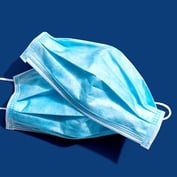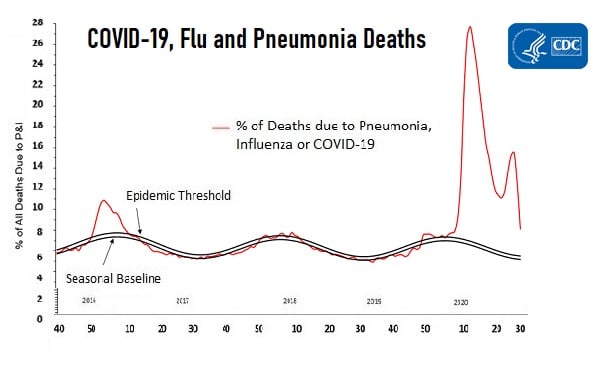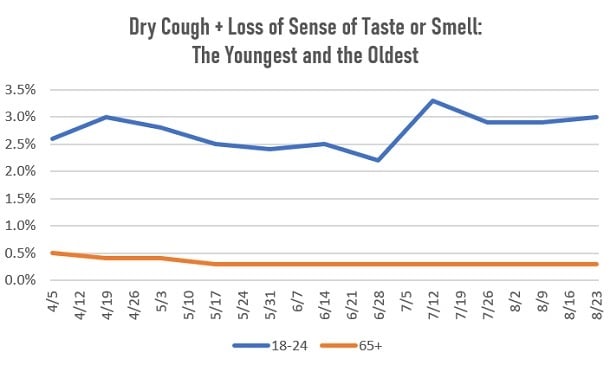The current wave of COVID-19 infections seems to be about half as deadly as the wave that hit the United States from March through early May.
Public health agencies often take weeks to get complete death data to the U.S. Centers for Disease Control and Prevention and other pubic and private pandemic trackers.
But, even after taking the data reporting lag into account, the total number of COVID-19-related deaths per day appears to be leveling off at roughly half the number of deaths per day in the spring.
Resources
- The Dynata COVID-19 symptom maps are available here.
- The CDC’s weekly COVID-19 report is available here.
- The COVID Tracking Project at The Atlantic is available here.
- The HHS hospital capacity data is available here.
- An overview article about the COVID-19 data for the previous week is available here.
One thing that still appears to be missing from the CDC data and other tracking programs’ data is information about the percentage of COVID-19 survivors, or survivors of working age, who report having breathing problems, kidney problems, heart problems or other problems that interfere with their ability to work, or to engage in everyday life activities, such as shopping, cleaning and cooking.
Health insurers have released little information about acute COVID-19 treatment costs, but, in the first half of the year, a sharp, pandemic-related decrease in spending on routine care freed up more than enough health insurer cash to pay for COVID-19 care.
Life insurers have indicated that, in the first half of the year, COVID-19 life insurance claims were manageable, partly because the mortality rate among people with life insurance has been less than half the mortality level for the general population.
Issuers of disability insurance and long-term care insurance did not report receiving any noticeable level of pandemic-related disability insurance claims, but it was not clear whether that was because of a modest level of pandemic-related disability or because of a lag between the onset of pandemic-related disability and when an insured files a disability claim.
One recently posted preprint, or academic study that has not gone through the full peer review process, suggests that 13.5% of the people who required at least 6 liters of oxygen while in the hospital with COVID-19, but who had intact cognitive function and who survived, were still using oxygen at home when they were surveyed about 30 to 40 days after they had left the hospital.
The Share of All U.S. Deaths Caused by COVID-19, and Conditions That Could Be COVID-19
The percentage of all U.S. deaths caused by COVID-19 and illnesses that look as if they could be COVID-19 continues to be over the epidemic thresholds for latest week. That indicator has fallen to 7.8% in the latest week, but the very newest figures have tended to get much higher as more states’ death numbers roll in.
For the week ending July. 13, data updates increased the indicator to 12.6%, from 8.1% based on the less complete data available last week.
But the death share indicator is still less than half of what it was in April.
COVID-19 Symptoms by Age Group
COVID-19 symptom survey results from Dynata, a market research survey firm, suggest one possible explanation: The age of people with COVID-19 may be falling.
Adults under 45 seem to be roughly 70% more likely to be hospitalized due to COVID-19 than due to seasonal flu, according to crude comparisons of differently structured CDC tables posted here and here.
But adults under 45 are about five times less likely to die from COVID-19 than people ages 65 to 74, according to CDC data.
The percentage of Dynata survey participants ages 65 and older who said they had both a dry cough and loss of either smell or taste started at just 0.5% in April and has fallen gradually to 0.3%. Older people seem to have accounted for about half of COVID-19 deaths because their COVID-19 death rate is very high, not because they were unusually likely to have COVID-19.
The percentage of Dynata survey participants ages 18 to 24 who said they had a dry cough with loss of smell or taste has moved up and down more dramatically. The percentage started at around 3% in the spring, fell to 2.2% as of late June, then spiked to 3.3% in the week ending July 12.
— Read COVID-19 Might Have Caused $2 Billion in U.S. Life Claims So Far, on ThinkAdvisor.
— Connect with ThinkAdvisor Life/Health on Facebook, LinkedIn and Twitter.







 August 24, 2020 at 05:56 PM
August 24, 2020 at 05:56 PM













 Slideshow
Slideshow





